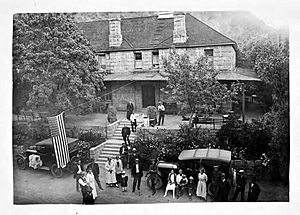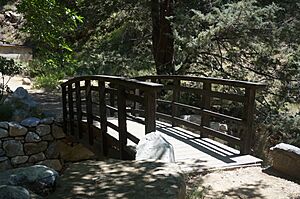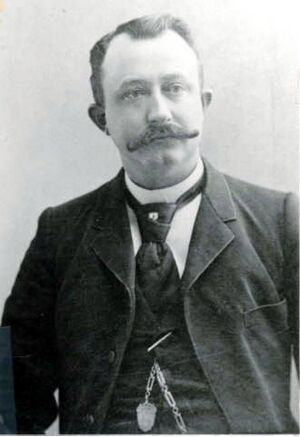Tassajara Hot Springs facts for kids
Tassajara Hot Springs is a special place with natural hot springs. It is located in the Ventana Wilderness area of the Santa Lucia Range in Monterey County, California. This area is part of the Los Padres National Forest.
For many years, Native American people used these hot springs. Europeans found them around 1843. Since 1868, the springs have been home to different resorts. At first, people reached them by a horse trail. Later, in 1886, a road was built for stagecoaches over Chews Ridge.
In 1870, Monterey County made the road to the resort a public highway. Charles Quilty bought the resort in 1886 and built a hotel from sandstone. His family owned the springs until 1945. The hotel was later rebuilt but burned down in 1949. Since 1967, Tassajara Hot Springs has been a Zen Buddhist monastery. It welcomes visitors during the summer months.
Contents
What's in a Name?
The name Tasajera comes from an old Esselen word. It means "a place where meat is hung to dry." The springs have also been called Tassajara Springs and Tesahara Springs. On old mining maps, they were known as Agua Caliente, which means "Hot Water" in Spanish.
Where is Tassajara?
The hot springs are about 28.3 miles (45.5 km) from Carmel Valley Road. The San Francisco Zen Center owns the springs. They run the Tassajara Zen Mountain Center there.
The last 8.2 miles (13.2 km) of the road to the springs are very narrow and steep. Visitors are encouraged to use four-wheel drive vehicles. You can also take a shuttle from Jamesburg, California. The Zen Center has offices in Jamesburg. Jamesburg is at the foot of Chews Ridge, about 13.8 miles (22.2 km) from the hot springs.
How the Hot Springs Work
In 1918, a report described the large amount of hot water at Tassajara Hot Springs. There are about seventeen hot springs in the creek bed and along its south bank. Their temperatures range from about 100°F (38°C) to 140°F (60°C). Some are just small trickles, while others flow at 8 US gallons (30 L) per minute.
The hot water comes from a type of rock called gneiss. This rock is visible along the creek for over 600 feet (180 m). The hot springs are in an area where the rocks underground are under a lot of pressure.
The water from two of the largest springs is piped into two plunge baths. There is also a vapor bath built over the hottest spring in the creek.
A Look Back in Time
First People: The Esselen
The Esselen people were the first to use these springs. They lived in the area for at least a thousand years before Europeans arrived. Native Americans from many tribes knew about Tassajara. They believed the springs had healing powers.
In 1843, a man named Jack Swan met a group of Native Americans. They were going to the springs to build a sweat lodge. They hoped to cure a skin disease. Swan wrote that many tribes would visit at once. There was plenty of wild game and fish for everyone.
European Settlers Arrive
Europeans found the springs in 1843. At first, it was very hard to get there. J. E. Rust built a cabin around 1868 but did not stay long.
In 1863, there was a short "silver rush" in the Tassajara area. Miners thought they would find gold and silver. The first mining claim was called "Vulcan Ledge." It included the "Agua Caliente" stream, which is Tassajara Hot Springs.
In 1885, Charles W. and Mary E. Quilty bought the springs. Charles hired a surveyor to build a road from James Ranch to Chew’s Ridge. Unemployed Chinese miners and railroad builders helped build the road. They worked for 50 cents a day and brought their own food.
Visitors traveled by stagecoach over a very rocky and steep road. The last part was so steep that a 20-foot (6.1 m) pine tree trunk was chained to the back of the stagecoach. This helped slow it down. Even today, the road is so narrow and rough that a modern four-wheel drive vehicle can take an hour to travel the 13.5 miles (21.7 km) from Jamesburg.
Who Owned the Springs?
Many people have owned the land over the years. J. E. Rust was the first to build a cabin there. In 1876, Jack Borden started advertising the resort. He sold his rights to William Hart, who put up tents and made the trail wider.
In 1904, Charles Quilty built a sandstone hotel. He hired Henry Arnold to blast rocks and cut blocks for the building. By 1909, the resort could host 75 people, with more staying in tents. A U.S. Post Office opened at the resort in 1912.
By 1918, a stagecoach ran twice a week from Salinas to the springs. This brought visitors from all over the country. By 1932, Charles's widow, Helen, ran two Pierce-Arrow stages daily. They carried guests and supplies.
The Quilty family owned the springs for 60 years. After Charles died, Helen continued to run the resort. She sold it in 1927 but bought it back in 1933. She operated it until 1945.
In 1945, Ralph "Cocky" Meyers and James Bundguard bought Tassajara. Meyers wanted to make it a very fancy resort. He planned to build a helicopter landing pad and an aerial tram. He even thought about a helicopter shuttle service from Salinas.
Later, actor Phil Terry owned the springs with his wife, Rosalind Lee. The large stone hotel burned down on September 9, 1949. Frank and Angela Sappok bought it in 1951. His family owned it for about 15 years until he died in an accident on the road. His wife sold it to Lester and Margaret Hudson. Margaret wanted to protect Tassajara from too much building, just like her father had protected Point Lobos.
In 1960, the Hudsons sold it to two couples, Fred and Nancy Roscoe and Robert and Anna Beck. The Becks soon bought out the Roscoes. The Becks made many improvements. They started the non-profit Tassajara Wilderness Trust. They also began offering workshops.
The San Francisco Zen Center became interested in buying the springs. They didn't have enough money at first. They raised funds from people like Chester Carlson, who founded Xerox. In December 1966, the Becks sold the springs for $300,000 to the San Francisco Zen Center. They renamed it the Zen Mountain Center. The Becks sold it for much less than they could have gotten from other buyers.
The Horse Pasture Land
A 153-acre (62 ha) piece of land near the springs was called The Horse Pasture. This flat meadow was where wranglers kept livestock when stagecoaches brought visitors. This land is inside the Ventana Wilderness in the Santa Lucia Mountains.
The Beck family owned this land until 2016. It was a great spot for outdoor activities. The Wilderness Trust wanted to protect this land. They worked with the Big Sur Land Trust and bought it for $1.1 million. The Wilderness Trust later gave the land to the United States Forest Service. Now, it is part of the Ventana Wilderness.
Fires at Tassajara
In September 1949, a fire started in a small cottage. It quickly spread to the main hotel and the nearby forest. The fire trapped 40 guests and 22 employees. It was stopped after burning 1,400 acres (570 ha).
In 2008, the hot springs were completely surrounded by the Basin Complex fire. Five staff members chose to stay behind. They went against the advice of professional firefighters. They successfully protected the resort from the fire.
Tassajara Zen Mountain Center
The San Francisco Zen Center owns the springs and the land around them. They bought it from Robert and Anna Beck. The site is now officially called Zenshinji, which means "Zen Heart-Mind Temple."
It is used all year as a training monastery by the Zen Center. From Memorial Day to Labor Day each year, the Zen Center rents out the simple rooms to visitors. Day visitors can also use the hot springs. During the rest of the year, it is used only by monks for intense practice. They follow a traditional schedule from ancient China.




